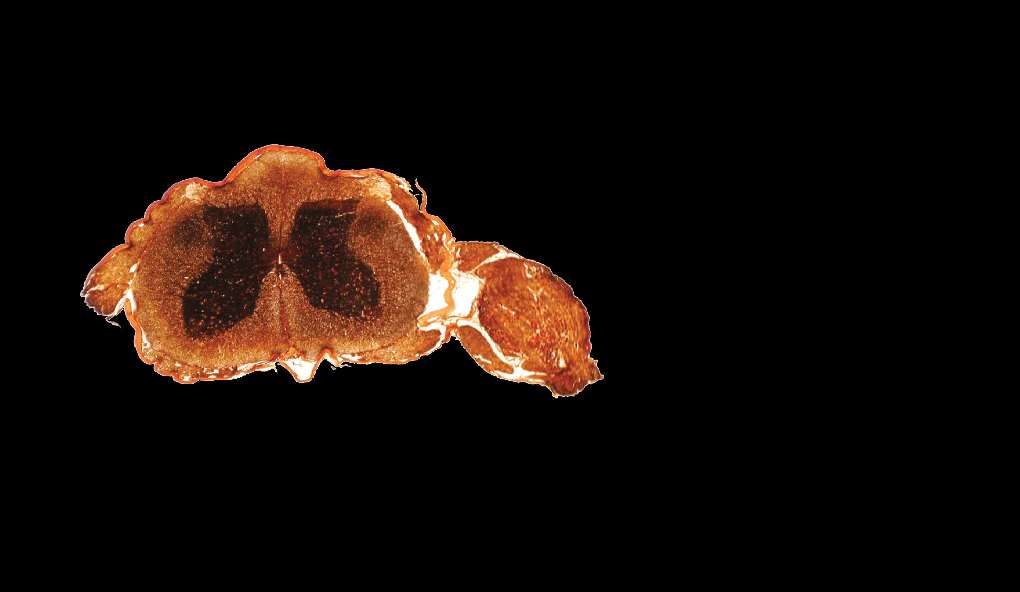Chapter 12. Between Body and Brain
12.1 Title slide

Between Body and Brain
Interact with depictions of the structures and pathways involved in tactile perception, proprioception, nociception, and thermoreception.
CLICK ANYWHERE TO BEGIN
Photo: Courtesy of David B. Fankhauser, Ph.D.
Along What Pathways Do Sensory Signals Flow Between the Body and the Brain?
Within the spinal cord and then from the spinal cord into the brain, sensory signals follow two different pathways: the dorsal column–medial lemniscal pathway (DCML pathway) for signals involved in tactile perception and proprioception and the spinothalamic pathway for signals involved in nociception and thermoreception.
A nerve fiber in the DCML pathway begins at its receptor ending in the skin or muscle, enters the ipsilateral dorsal column of the spinal cord, and runs up the dorsal column into the medulla, in the brain stem, where it makes a synapse with a relay neuron. The axon of the relay neuron crosses to the contralateral side in the medulla and then, as part of a bundle of axons called the medial lemniscus, runs up to the ventral posterior nucleus of the thalamus, where it makes a synapse. From this synapse, a connecting neuron carries signals into the contralateral somatosensory cortex.
A nerve fiber in the spinothalamic pathway begins at its receptor ending in the skin or muscle and enters the ipsilateral dorsal horn of the spinal cord, where it makes a synapse with a relay neuron. The axon of the relay neuron crosses to the contralateral side of the spinal cord and then, as part of a bundle of axons called the spinothalamic tract, runs up the spinal cord and into the brain, to the ventral posterior nucleus of the thalamus, where it makes a synapse. From this synapse, connecting neurons carry signals into the contralateral somatosensory cortex (providing information about the discriminative aspects of pain perception and thermoreception) and to the insular cortex and the anterior cingulate cortex (providing information about the affective aspects of pain perception).
12.2 Explain - dnd
Drag and drop each of the labels into the correct box on this illustration of a cross section through the spinal cord and an associated dorsal root ganglion.
12.3 Explain - dnd
Drag and drop each of the labels into the correct box on this illustration of the somatosensory pathways.
Dorsal column-medial lemniscal pathway
Medial lemniscus
Dorsal horn
Somatosensory cortex
Spinothalamic pathway
Spinal cord
Signals to anterior cingulate cortex
Signals to insular cortex
Spinothalamic tract
Ventral posterior nucleus of thalamus
Dorsal root ganglion
Medulla
12.4 Explain
Along What Pathways Do Sensory Signals Flow Between the Body and the Brain?
The axons of sensory receptors (including mechanoreceptors, nociceptors, and
thermoreceptors) within a small area of the skin converge into a peripheral nerve bundle. Similarly, the axons of sensory neurons involved in
proprioception within a muscle or joint converge into a nerve bundle. Then all the nerve bundles from each region of skin and each region of
muscle tissue enter the spinal cord via one of the spinal nerves. The cell bodies of all these neurons cluster together into a single dorsal
root ganglion. Each dorsal root ganglion is adjacent to a single vertebra; each vertebra has one ganglion on the left side and one on the right.
The dorsal root—the bundled-together axons of dorsal root ganglion cells—enters the dorsal part of the spinal cord.
Within the spinal cord and then from the spinal cord into the brain, sensory signals follow two different pathways: the dorsal
column–medial lemniscal pathway (DCML pathway) for signals involved in tactile perception and proprioception and the spinothalamic pathway for
signals involved in nociception and thermoreception.
A nerve fiber in the DCML pathway begins at its receptor ending in the skin or muscle, enters the ipsilateral dorsal column of the spinal
cord, and runs up the dorsal column into the medulla, in the brain stem, where it makes a synapse with a relay neuron. The axon of the relay
neuron crosses to the contralateral side in the medulla and then, as part of a bundle of axons called the medial lemniscus, runs up to the
ventral posterior nucleus of the thalamus, where it makes a synapse. From this synapse, a connecting neuron carries signals into the
contralateral somatosensory cortex.
A nerve fiber in the spinothalamic pathway begins at its receptor ending in the skin or muscle and enters the ipsilateral dorsal horn of
the spinal cord, where it makes a synapse with a relay neuron. The axon of the relay neuron crosses to the contralateral side of the spinal cord
and then, as part of a bundle of axons called the spinothalamic tract, runs up the spinal cord and into the brain, to the ventral posterior
nucleus of the thalamus, where it makes a synapse. From this synapse, connecting neurons carry signals into the contralateral somatosensory
cortex (providing information about the discriminative aspects of pain perception and thermoreception) and to the insular cortex and the
anterior cingulate cortex (providing information about the affective aspects of pain perception).
12.5 Test - single choice
Select your answer to the question below. Then click SUBMIT.
Where are the cell bodies of sensory receptors located?
12.6 Test - single choice
Select your answer to the question below. Then click SUBMIT.
The dorsal column-medial lemniscal pathway travels up the spinal cord on the ________ side while the spinothalamic pathway crosses the spinal cord and travels on the ________ side.
12.7 Test - single choice
Select your answer to the question below. Then click SUBMIT.
You are cooking dinner one night and you drop your spoon into a boiling pot of water on the stove. You react by reaching into the boiling water to grab the spoon and feel the scalding sensation as you quickly withdraw your hand from the water. Which pathway did the pain signal travel to get to your brain?
12.8 Activity completed
Between Body and Brain.